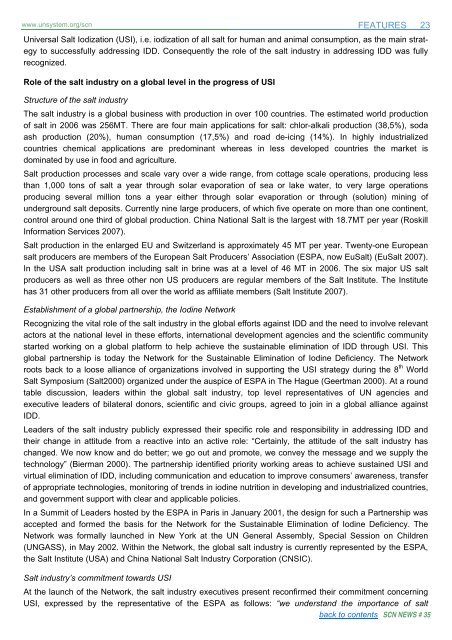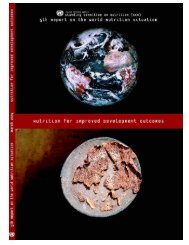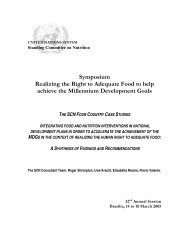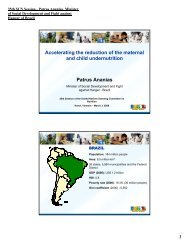Universal Salt Iodization (USI) - FTP Directory Listing
Universal Salt Iodization (USI) - FTP Directory Listing
Universal Salt Iodization (USI) - FTP Directory Listing
- No tags were found...
You also want an ePaper? Increase the reach of your titles
YUMPU automatically turns print PDFs into web optimized ePapers that Google loves.
www.unsystem.org/scn FEATURES 23<strong>Universal</strong> <strong>Salt</strong> <strong>Iodization</strong> (<strong>USI</strong>), i.e. iodization of all salt for human and animal consumption, as the main strategyto successfully addressing IDD. Consequently the role of the salt industry in addressing IDD was fullyrecognized.Role of the salt industry on a global level in the progress of <strong>USI</strong>Structure of the salt industryThe salt industry is a global business with production in over 100 countries. The estimated world productionof salt in 2006 was 256MT. There are four main applications for salt: chlor-alkali production (38,5%), sodaash production (20%), human consumption (17,5%) and road de-icing (14%). In highly industrializedcountries chemical applications are predominant whereas in less developed countries the market isdominated by use in food and agriculture.<strong>Salt</strong> production processes and scale vary over a wide range, from cottage scale operations, producing lessthan 1,000 tons of salt a year through solar evaporation of sea or lake water, to very large operationsproducing several million tons a year either through solar evaporation or through (solution) mining ofunderground salt deposits. Currently nine large producers, of which five operate on more than one continent,control around one third of global production. China National <strong>Salt</strong> is the largest with 18.7MT per year (RoskillInformation Services 2007).<strong>Salt</strong> production in the enlarged EU and Switzerland is approximately 45 MT per year. Twenty-one Europeansalt producers are members of the European <strong>Salt</strong> Producers’ Association (ESPA, now Eu<strong>Salt</strong>) (Eu<strong>Salt</strong> 2007).In the USA salt production including salt in brine was at a level of 46 MT in 2006. The six major US saltproducers as well as three other non US producers are regular members of the <strong>Salt</strong> Institute. The Institutehas 31 other producers from all over the world as affiliate members (<strong>Salt</strong> Institute 2007).Establishment of a global partnership, the Iodine NetworkRecognizing the vital role of the salt industry in the global efforts against IDD and the need to involve relevantactors at the national level in these efforts, international development agencies and the scientific communitystarted working on a global platform to help achieve the sustainable elimination of IDD through <strong>USI</strong>. Thisglobal partnership is today the Network for the Sustainable Elimination of Iodine Deficiency. The Networkroots back to a loose alliance of organizations involved in supporting the <strong>USI</strong> strategy during the 8 th World<strong>Salt</strong> Symposium (<strong>Salt</strong>2000) organized under the auspice of ESPA in The Hague (Geertman 2000). At a roundtable discussion, leaders within the global salt industry, top level representatives of UN agencies andexecutive leaders of bilateral donors, scientific and civic groups, agreed to join in a global alliance againstIDD.Leaders of the salt industry publicly expressed their specific role and responsibility in addressing IDD andtheir change in attitude from a reactive into an active role: “Certainly, the attitude of the salt industry haschanged. We now know and do better; we go out and promote, we convey the message and we supply thetechnology” (Bierman 2000). The partnership identified priority working areas to achieve sustained <strong>USI</strong> andvirtual elimination of IDD, including communication and education to improve consumers’ awareness, transferof appropriate technologies, monitoring of trends in iodine nutrition in developing and industrialized countries,and government support with clear and applicable policies.In a Summit of Leaders hosted by the ESPA in Paris in January 2001, the design for such a Partnership wasaccepted and formed the basis for the Network for the Sustainable Elimination of Iodine Deficiency. TheNetwork was formally launched in New York at the UN General Assembly, Special Session on Children(UNGASS), in May 2002. Within the Network, the global salt industry is currently represented by the ESPA,the <strong>Salt</strong> Institute (USA) and China National <strong>Salt</strong> Industry Corporation (CNSIC).<strong>Salt</strong> industry’s commitment towards <strong>USI</strong>At the launch of the Network, the salt industry executives present reconfirmed their commitment concerning<strong>USI</strong>, expressed by the representative of the ESPA as follows: “we understand the importance of saltback to contents SCN NEWS # 35







